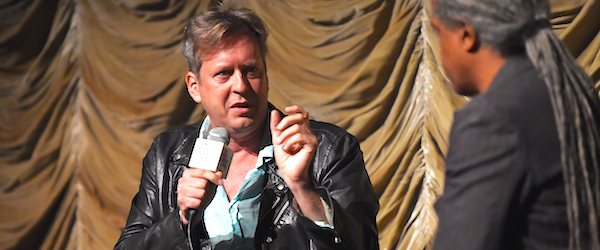Doug Aitkin on Fighting Narrative Convention in Station to Station
Recently, Film Independent at LACMA hosted a screening of Station to Station, a non-linear, non-narrative documentary by multimedia artist Doug Aitkin that chronicles a train ride across the United States.
At the Q&A that followed, Film Independent Curator Elvis Mitchell noted that, “In movies you’re always a step ahead; you always know where you’re going to be. You know there’s a three-act structure, even if it’s jumbled around—and there’s none of that here.”
Aitkin had originally attempted to assemble his footage into a conventionally structured film, but it soon became clear that such a structure wasn’t possible without sacrificing the heart of the project.
“When the project was over and we got back to the studio, we had this very wide, diverse amount of footage,” said Aitkin. “Initially, we looked at that and thought, ‘Do we make a documentary out of this? Do we take this huge cloud of information and compress into something that is very linear, very structured, like a feature film?’ At first we tried to do that, but after a couple of months, trying a version with voice-over, trying to go from the East Coast to the West Coast, I woke up one morning and felt it was absolutely corrupt.”
That’s when Aitkin came up with the plan to cut the footage into 62 individual short films.
“We were interested in making a film that was almost molecular. Every minute was its own piece, but together they create this larger, rhythmic composition,” he said.
Mitchell likened the film to music, which brought up an interesting anecdote from Aitkin’s own artistic discussions. “I was talking to Bono. We were talking about minimalist music. And he said, ‘For me, the first music that I ever really listened to was Kraftwerk’s The Man-Machine.’”
Aitkin told how Bono saved five dollars, bought the album, came home, lit candles and listened to it with his girlfriend. “First of all I thought that was kind of weird. And cool,” said Aitkin.

He continued: “Bono said, ‘To me this was modern folk music. We all hear the pulsing sound of our iPhones, we’re surrounded by patterns and repetition.’ I wanted to speak to the idea of that in this film.”
“It’s about moving on, one thing leading to another, a sense of synchronicity,” said Aitkin.
Aitkin offered another story, this time of a conversation he had with Robert Altman. The Nashville director was talking about his early days making industrial films for the military. For one particular assignment, he was tasked with creating an instructional video for how to fly a plane. It was a conventional, step-by-step-video, and by the time the lights turned on after the first screening, many of the soldiers had fallen asleep.
So Altman went back to the drawing board and came up with a plan to split the footage in three.
“Something that was a thirty-minute film became three different films that added up to thirty minutes. They ran three different projections, all playing at once, each showing different aspects of how to fly a plane. The soldiers took the test. Everyone passed.”
“Altman said, ‘The way I’ve been creating film in the past, this linear thing, is not doing justice to the capacity and the potential of the human mind. And maybe if you throw something out there that’s seemingly confusing, it’ll inspire someone to watch and dig a little deeper.”
In Station to Station, Aitkin applied this theory 62 times.
“I felt there was some way we could take the idea of time, cinema’s time, and if we could democratize it, break it down into these uniform pieces, then there might be a chance to create something different.”
Daniel Larios / Film Independent Blogger